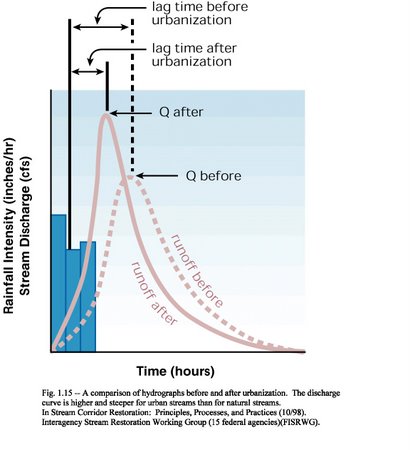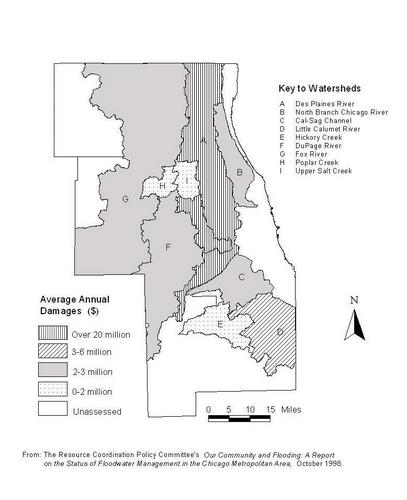The Importance of Stormwater Management
The Importance of Stormwater Management
Stormwater management is an important component of the Chicago Metropolitan Agency for Planning's (CMAP) GO TO 2040 regional comprehensive plan. The 2040 Regional Vision states that "water will be treated as a critical natural resource and water resource planning will be a high regional priority." Strong stormwater management programs throughout the region play a significant role in accomplishing this goal. Regional interest in stormwater management has been strong for a number of years. A predecessor agency to CMAP, the Northeastern Illinois Planning Commission (NIPC), published the "Strategic Plan for Water Resource Management" in 2002. This document was prepared as long-term guidance for stormwater management in the region. A number of recommendations regarding stormwater management issues are outlined in this document that both NIPC and other regional and local actors have promoted.
 |
|
Figure 2: Before and After Development Hydrographs |
The first study that investigated the effects of urban stormwater runoff on water quality was the US Environmental Protection Agency's (USEPA) Nationwide Urban Runoff Program (NURP) in 1983. The program studied the quality of the stormwater runoff at 28 sites throughout the United States. Lake Ellyn in Glen Ellyn was site chosen for the region. The program found that untreated stormwater contains unsafe levels of heavy metals, especially copper, lead and zinc. Stormwater was also found to have high levels of coliform bacteria. This study was the first to specifically identify the pollutants that were responsible for the "water quality problem". At the time it was acknowledged that there was a problem but what was causing it and the exact agents responsible were unknown. (Results of the Nationwide Urban Runoff Program: Executive Summary)
Stormwater pollutants commonly come from a variety of sources that are throughout the landscape, such as parking lots, roads, farm fields, etc. This type of pollution is called non-point source pollution. Non-point source pollution is becoming a larger problem throughout the metropolitan region. Since the region is very large and diverse, each area has its own unique set of challenges regarding stormwater quality.
One reason stormwater management is an important consideration for local governments is that storm events in urban areas tend to be more "flashy" than rural storm events. This term describes how quickly the water appears in storm sewers or streams and how quickly it then recedes when compared to natural conditions.
Figure 2 displays hydrographs before and after development. A hydrograph compares the runoff rate versus time. The hydrograph after urbanization peaks sooner and recedes much faster than the natural conditions hydrograph. The water post development travels at a much faster rate because of the increase in impervious and smooth surfaces. Water will travel down a concrete driveway much faster than it will through the adjacent lawn. Flashiness tends to damage streams by causing increased erosion with moderately large storm events. Stormwater management is partly meant to control this increased flashiness and keep it from damaging property and the natural environment. The usual means of doing so is to provide detention storage, releasing water more slowly than it would be otherwise.
Flooding damages many homes and properties throughout the region every year. Figure 3 displays estimates of annual damages per watershed. The watershed that experiences the greatest amount of damage is the highly urbanized Des Plaines River watershed. The main stem and tributaries of the Des Plaines River have experienced degradation due to flashy storm events and stormwater quality. According to the National Flood Insurance Program, the average annual flood losses are estimated at $2.4 billion throughout the country (Flood Smart). Reducing the volume of runoff can also be a goal of stormwater management. It is especially important because a number of areas in the region have combined sewers. Combined sewers are sewers that carry both sanitary and stormwater flows. During storm events the sewer system can frequently become overwhelmed and discharge the stormwater and sanitary water directly into bodies of water. These discharges are called Combined Sewer Overflows (CSOs). If the amount of stormwater runoff can be reduced, the number of CSO discharge events can also be reduced. CSOs are further described in the Wastewater Planning Strategy Paper.
 |
| Figure 3: Average Annual Flood Damage |